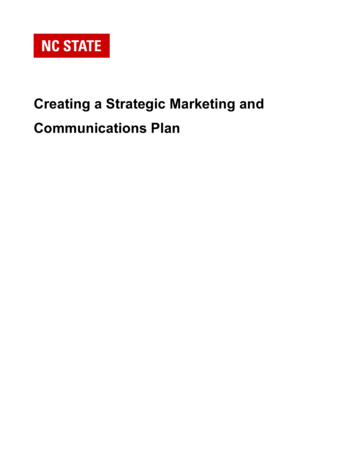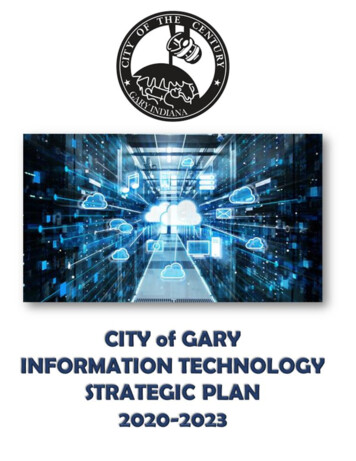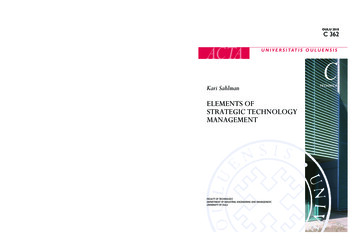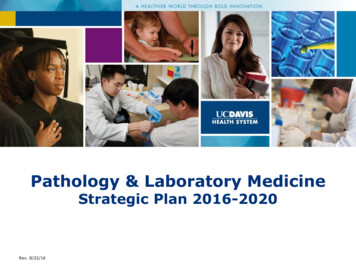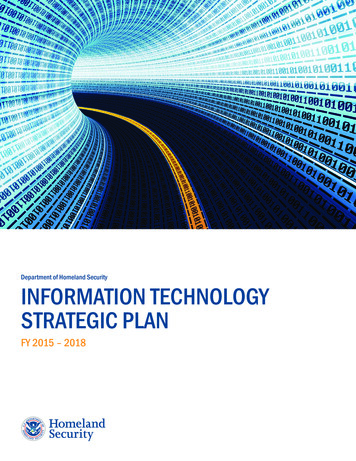
Transcription
Department of Homeland SecurityINFORMATION TECHNOLOGYSTRATEGIC PLANFY 2015 – 2018
TABLE OF CONTENTSMessage from DHS Chief Information Officer.04Endorsements.05Introduction.06Mission, Vision, Principles.07DHS IT Strategic Plan Overview.09Goals and Objectives.10Goal 1: People and Culture.10Goal 2: Innovative Technology.12Goal 3: Service Delivery.14Goal 4: Cybersecurity.16Goal 5: Governance and Accountability.18Strategic Alignment.20Strategic Planning Process.21Operational Plan Objectives (OPAs).22DHS INFORMATION TECHNOLOGY STRATEGIC PLAN FY 2015 – 20183
Message from the DHS CIOIt is with great pleasure that I share with you the Department ofHomeland Security Information Technology Strategic Plan 2015-2018,our first revision of the IT Strategic Plan since 2011, and a criticalelement toward achieving “IT excellence”– that is, the most advanced,efficient, and effective management of IT and related services andresources, at every level.Luke J. McCormackDepartment of Homeland SecurityChief Information OfficerDHS’ missions are wide-ranging, but our goal is clear: a safer, moresecure America, resilient against terrorism and other potential threats.DHS IT has a powerful role to play. New technologies continue to emergeat a rapid pace, security threats grow increasingly sophisticated, andthere are fewer resources and dollars government-wide. To adapt, weintend to fundamentally transform how DHS does business.The DHS IT Strategic Plan is our coordinated effort to integrate people,processes, technology, information, and governance in a way that fullysupports the needs of our workforce, our partners, our customers,and the American public, while addressing our ever-evolving missionchallenges. It provides direction and guidance on advancing IT capabilitiesand resources in order to improve the Department’s operational efficiency,mission effectiveness, and front-line operations.This plan was developed through the powerful collaboration madepossible by Secretary Jeh C. Johnson’s “Unity of Effort” initiative, engagingall levels of OCIO and the CIO Council, whose members represent the ITcommunities of every DHS Component.The result: a focused, mission-driven, achievable plan that positionsour technology environment to address the critical areas of people andculture, innovative technologies, cybersecurity, and governance andaccountability.The 2015-2018 DHS IT Strategic Plan is a guide for the IT communityboth within and outside of DHS, as we work together to deliver effective,efficient services and solutions that ultimately provide for the security ofthe American people.4DHS INFORMATION TECHNOLOGY STRATEGIC PLAN FY 2015 – 2018
ENDORSEMENTSThe DHS Chief Information Officer Council“The DHS CIO Council sets the vision and strategy for the Information Technology function and informationresources within the Department of Homeland Security, and leads the delivery of information technologyenabled mission capabilities in a timely and effective manner.” DHS CIO COUNCIL CHARTERLuke J. McCormackDepartment of Homeland SecurityChief Information OfficerMargaret H. GravesDepartment of Homeland SecurityDeputy Chief Information OfficerCharles ArmstrongU.S. Customs and Border ProtectionChief Information OfficerStephen RiceTransportation Security AdministrationChief Information OfficerRobert DilonardoDomestic Nuclear Detection OfficeChief Information OfficerMark A. SchwartzU.S. Citizen and Immigration ServicesChief Information OfficerRobert J. DuffyOffice of Inspector GeneralChief Information OfficerClark SmithIntelligence and AnalysisChief Information OfficerDave EppersonNational Protection and Programs DirectorateChief Information OfficerSteven SmithU.S. Immigration and Customs EnforcementChief Information Officer (Acting)Adrian R. GardnerFederal Emergency Management AgencyChief Information OfficerRick StevensScience and TechnologyChief Information OfficerRADM Marshall B. Lytle IIIU.S. Coast GuardChief Information OfficerBarbara WhitelawDHS Office of the Chief Information OfficerChief of StaffSandy H. PeavyFederal Law Enforcement Training CenterChief Information OfficerDHS INFORMATION TECHNOLOGY STRATEGIC PLAN FY 2015 – 20185
INTRODUCTIONDHS Information TechnologyStrategic Plan 2015 – 2018The Department of Homeland Security (DHS) has a vital mission:to secure the nation from the many threats it faces. The DHS vision is toensure a homeland that is safe, secure, and resilient against terrorismand other hazards. These overarching goals are the basis for the ITmission and IT vision set forth in this document; the strategies andactions of the DHS CIO community are rooted in and aligned with thefounding principles and highest priorities of Homeland Security.The DHS IT Strategic Plan 2015-2018 reflects our rapidly-changingIT environment and evolving mission and business needs, as well asIT’s role in every aspect of security and resilience. It outlines DHS’ ITpriorities and provides strategic direction for the use of IT resources,in order to improve the efficiency of our programs, enhance ourmission effectiveness, and ultimately, provide for the security of theAmerican people.As part of its strategic planning process, DHS cross-Componentleadership developed five high-level goals, each with no more thanfour achievable objectives. In addition, each goal and its objectiveswere given an outcome; that is, the intended end state once the goaland objectives are complete.The IT Strategic Plan collectively supports the strategies outlined inthe Department’s Strategic Plan for fiscal years 2012-2016 and themission, goals, and objectives outlined in the 2014 QuadrennialHomeland Security Review (QHSR). It is an update to the DHSInformation Technology Strategic Plan for fiscal years 2011-2015.The execution of the strategies in this plan is to be carried out underthe leadership of the DHS CIO Council.6“Just astechnologyhas rapidlychanged ourdaily lives,so too has ittransformed DHS’opportunitiesfor achievingits mission.”Homeland Security CIOLuke McCormackDHS INFORMATION TECHNOLOGY STRATEGIC PLAN FY 2015 – 2018
MISSION, VISION, PRINCIPLESWith more than 240,000 employees stationed around the world, it is DHS’ goal to serve as a unified force.In some way, every day, every employee contributes to the safety and resiliency of the nation.Using the DHS and DHS IT visions and missions as its foundation, the DHS IT Strategic Plan 2015-2018 isdesigned as a consistent, responsible, and achievable plan that strengthens the Department’s ability toaccomplish its mission and support employees and partners.In addition, the plan reflects DHS’ IT principles -- those key elements that are the standard for how DHSconducts the business of IT.DHS Vision5DHS Core MissionsA homeland that is safe, secure, and resilient against terrorism and other hazards,where American interests, aspirations, and way of life can thrive.1. Prevent Terrorism and Enhance Security2. Secure and Manage Our Borders3. Enforce and Administer Our Immigration Laws4. Safeguard and Secure Cyberspace5. Strengthen National Preparedness and ResilienceDHS IT MissionEnable the DHS mission through excellence in information technology.DHS IT VisionDHS IT enables secure resilient capabilities to achieve interoperability,information sharing, and unity of effort for DHS and its partners.DHS INFORMATION TECHNOLOGY STRATEGIC PLAN FY 2015 – 20187
Who we are,what we represent,how we do business:Principles People First: Our workforce is our priority. We create an open, honest,caring workplace where individuals have opportunities to test their potential. Secure: We are multi-threat and all-hazard ready. We have a smart, effective,efficient, risk-based approach to security. We are prepared and resilient. Innovative: We provide the information and tools to enable innovativeproblem solving. We partner with industry to bring smart innovations fromthe private to the public sector. Integrity: We do no harm. We are transparent and fair. Results Oriented: We are flexible, responsive, and service minded.We recognize the urgency of our missions. Efficient: We are cost effective, efficient, and look for innovative solutions.We share resources. Collaborative: We choose to partner first, to coordinate and leverage efforts.We are interoperable and integrated.“Our collective goalis to better understandthe broad andcomplex DHS missionspace and empowerDHS Components toeffectively executetheir operations.”Homeland Security SecretaryJeh C. Johnson8DHS INFORMATION TECHNOLOGY STRATEGIC PLAN FY 2015 – 2018
DHS ITSTRATEGIC PLANOverviewIT VISIONFive Homeland Security Missions:1. Prevent Terrorism & Enhance Security2. Secure & Manage Our Borders3. Enforce & Administer Our Immigration Laws4. Safeguard & Secure Cyberspace5. Strengthen National Preparedness & ResilienceDHS IT enables secure resilient capabilities to achieve interoperability, information sharing, & unity of effort for DHS & its partners.IT MISSIONEnable the DHS mission through excellence in information technology.PRINCIPLESPeople First Secure Innovative Integrity Results-oriented Efficient CollaborativeGOALS & OBJECTIVES1Goal:People &CultureAttract & develop anengaged & skillful ITworkforce to ensurelong-term missionsuccess.Objectives:1.1 Attract, develop & maximizeretention, engagement &productivity of a high-caliberIT professional workforcethrough inclusive, effectiveleadership & investment insuccession planning &employee development.1.2 Solidify a unified cultureof mission-focused &results-oriented performanceacross the DHS IT communityto increase organizationalperformance.1.3 Enable the DHS workforceto execute its responsibilitiesmore effectively throughaccess to data & DeliveryTransform the DHSworkplace by enablingend user capabilitiesthrough access to data& services anywhere,anytime.Establish a model forcontinuous businessprocess improvementthat enables transparent,data-driven decisions &rapid delivery of highquality IT capabilities.Objectives:2.1 Optimize the end userexperience with data, access,& services, providing costefficiencies & workforceproductivity.Objectives:3.1 Enhance IT capabilitiesof DHS & its partners byensuring operational excellence,framed by service levelagreements that meet therequirements of the mission.2.2 Develop interoperabletechnologies that enabledetection of & resilienceagainst threats.3.2 Create a customerservice model to improvedelivery of high quality ITservices, including transparentexpenditures & consumptionbased costs.2.3 Advance the implementation of the Homeland SecurityInformation Sharingenvironment.2.4 Enable end-to-enddelivery of mobile solutionsthat enhance enterprise-widemobile computing capabilitiesfor successful missionoutcomes.3.3 Advance the adoptionof scalable, flexible,cost-effective, accessibleservices through enterprise& brokered service offerings.3.4 Promote effective, timely,& informed decision-makingthrough analytic, knowledgebased technologies & workflowprocess re-engineering.4Goal:CybersecurityEmpower DHS & itspartners to operatesecure IT systems& networks, keepingahead of evolvingcyber threats.Objectives:4.1 Adopt risk-based commonpolicies & best practices thatmeet & anticipate compliancestandards to effectivelyeliminate vulnerabilities &mitigate cybersecurity threats.4.2 Enable secure communications to effectively support themission of DHS & its partners.4.3 Enhance the DHS securitymodel by moving to anext-generation networksecurity architecture thataccommodates public cloudservices, improves on currentPEP structure, & integratesnew technologies.5Goal:Governance &AccountabilityImprove the ITenvironment throughthe maturation of ITgovernance &accountability.Objectives:5.1 Streamline reportingprocesses to allow forincreased focus on workloadproductivity.5.2 Improve transparencyof IT costs through enhancedservice & performance metrics.5.3 Employ robust governanceprocesses for guiding ITinvestments that includesroles & responsibilities atboth DHS Headquarters& Component levels.5.4 Promote strategic sourcingor other procurement vehiclescapable of enabling missioncritical activities for moreefficient & cost-effectiveprovision of services.OUTCOMES123An engaged IT workforce thatpossesses relevant skill sets,provides innovative ITsolutions & works collaboratively to support missiondemands.IT resources, includingnetworks, systems & data,are available for the rightpeople, at the right time,in the right locations, forimproved mission execution.The DHS workforce is mobile,interoperable & secure.IT services operate inaccordance with servicelevel agreements. IT businessprocesses support thetransition from traditionalservice provider models tonew broker models, includingtransparent, consumptionbased billing.DHS INFORMATION TECHNOLOGY STRATEGIC PLAN FY 2015 – 20184IT systems & networksare proactively managed& monitored to ensureweaknesses are identified,compliance with bestpractices is maintained &risk-based strategies arein place to adjust to rapidchanges in the threatlandscape.5Enterprise IT governance &management practices drivedecision-making to achieveefficiencies, maximizeinvestment value & optimizeIT support for successfulmission outcomes. Roles &responsibilities are clearlydefined, ensuring transparency& accountability.9
GOAL 1: PEOPLE AND CULTUREGoal: Attract and develop an engaged and skillful IT workforce toensure long-term mission success.The DHS missions are challenging, budgets are limited, and IT is evolving at a rapidpace. Successful execution of all DHS missions demands a well-informed, agile,connected, and unified workforce to anticipate, detect, target, and disrupt threats.Attracting, developing, and retaining the highest-quality workforce that can meettoday’s and tomorrow’s challenges is critical to all of the DHS Componentsand missions.Outcomes:An engaged IT workforce that possesses relevant skill sets, provides innovative ITsolutions, and works collaboratively to support mission demands.“DHS remains committedto building and sustaininga world-class cybersecurityteam by hiring andretaining a diverseworkforce with experiencein information technology,computer science, networkand computer engineering,information assurance,and program management.”Homeland Security Deputy SecretaryAlejandro Mayorkas10
Objectives1.1 Attract, develop, and maximize retention,engagement, and productivity of a high-caliber ITprofessional workforce through inclusive, effectiveleadership and investment in succession planningand employee development.DHS is creating a work environment that offersemployees greater opportunity for career development and cross-training, and that develops andmaintains effective, skilled leadership who fosteran inclusive environment where employees feelengaged, productive, and valued. This environmentis especially important in attracting and developingan IT workforce with the critical skillsets needed totransform the organization. The Department willcontinue to implement strategies to close potentialskill gaps through vigorous outreach, recruiting,training, and succession planning. Outreach initiatives with universities, industry, technical trainingcenters, and DoD transition centers will continue.1.2 Solidify a unified culture of mission-focusedand results-oriented performance across the DHS ITcommunity to increase organizational performance.DHS is committed to continuous employee trainingthat includes not only the IT skills required, but thatemphasizes development of mission-focuseddiscipline, a security mindset, and innovativeproblem-solving. DHS will strengthen workforcemorale and performance through the promotionof a culture of accountability that recognizes andrewards results.1.3 Enable the DHS workforce to execute itsresponsibilities more effectively through accessto data and technology.DHS will empower employees by improving information sharing and communications. By developing aninnovative contemporary communication frameworkand by provisioning flexible mobile tools, DHS willenhance workforce effectiveness in field offices,on the border, and in headquarters, improvingservice to and the security of the American public.Example: DHS IT Immersion ProgramThe DHS IT Immersion Program is a highly interactive program designed to provide new employeeswith a deep understanding of the complexities and collaboration opportunities that exist acrossthe DHS IT community. Newly-hired information technology employees across the Departmentspend a day with colleagues and senior leadership, engaged in discussions on Component activities, career management, and the variety of work across the DHS IT community. This opportunityto connect with IT professionals across DHS establishes a strong foundation for a fulfilling careerwithin DHS IT.DHS INFORMATION TECHNOLOGY STRATEGIC PLAN FY 2015 – 201811
GOAL 2: INNOVATIVE TECHNOLOGYGoal: Transform the DHS workplace by enabling end user capabilitiesthrough access to data and services anywhere and anytime.People are able to interact with the world around them in new ways due to theubiquity of network connectivity and the proliferation of smart devices. Everyonewants real-time data and analytics. Our goal is to make technologies available toprovide the right information, to the right people, at the right time, in order to helpDHS workers perform with greater efficiency, productivity, and safety.Outcomes:IT resources, including networks, systems, and data, are available for the rightpeople, at the right time, in the right locations, for improved mission execution.The DHS workforce is mobile, interoperable, and secure.“We mustharness newideas andtechnology toremake ourgovernment ”President Barack Obama12
Objectives2.1 Optimize the end user experience with data,access, and services, providing cost efficienciesand workforce productivity.DHS will develop a data road map, including anacquisition strategy and implementation plan,of existing Department data. Building on previousefforts toward data aggregation, DHS will workcollaboratively throughout the organization to provideinformation to leadership and employees on the datacontained within the systems, and on opportunitiesto create accessible data sets and to present betterinformation to decision makers.2.2 Develop interoperable technologies thatenable detection of and resilience against threats.The Department is furthering the investment in theJoint Wireless Program Office (JWPMO) to improvetactical communications (TacCom), and achieve andmaintain interoperable communications capabilities.The JWPMO will focus on a Land-Mobile-Radio (LMR)backbone solution for the Department, as well asa technical refresh for TacCom. This represents aunified effort across the enterprise to assess gapsand obstacles, and develop a roadmap to successfulinteroperable communications.2.3 Advance the implementation of the HomelandSecurity information sharing environment.The DHS CIO community will continue to growits information sharing capacity by adopting acollaborative, mission-centric approach; utilizingshared technology platforms; embracing a customerfocused information delivery model; and integratingsecurity and privacy into technology solutions.This will include evolving an information sharingsegment architecture; developing agile and missionbased information sharing platforms and applications;and establishing strong governance, succinct strategy,enforceable policy, and clear standards.2.4 Enable end-to-end delivery of mobile solutionsthat enhance enterprise-wide mobile computingcapabilities for successful mission outcomes.DHS is advancing a mobile computing environmentto enhance mission effectiveness, improve the enduser experience, and enable cost reductions in bothhardware and device support. The transformation isalready underway and will require strong collaborationwith IT stakeholders, customers, partners, andindustry to execute. As technology evolves, DHSwill move beyond its current capabilities to provideadditional features and services to the mobile enduser device and application computing environment.Example: CarwashThe DHS Carwash is a one-stop-shop for mobile application testing and development. The project issponsored under DHS OCIO for all Federal agencies, and provides a streamlined process by whichgovernment development teams can expedite the building, testing, and deployment of applications.DHS Carwash supports DevOps processes and is capable of supporting commonly-used developmentmethodologies such as Agile or Waterfall. It is a shared service that can be used in the developmentof secure and compliant applications within and outside of the federal government.DHS INFORMATION TECHNOLOGY STRATEGIC PLAN FY 2015 – 201813
GOAL 3: SERVICE DELIVERYGoal: Establish a model for continuous business process improvementthat enables transparent, data-driven decisions and rapid delivery ofhigh-quality IT capabilities.DHS is using new IT developments to increase business productivity. How DHS doesbusiness directly affects its ability to obtain and implement the latest IT developmentsin a timely and effective manner. DHS business owners must institutionalize a crosslines-of-business, cross-Component, and cross-DHS mentality to not only maximize theeffectiveness of IT investments, but also to adopt a strong, customer service-orientedmodel for doing business.The DHS CIO and Component CIOs will work in partnership with Component and Headquarters chief executive officers to transform the DHS business model to adapt to thecontinuously changing IT environment, and to become a true model of customer service.Outcomes:IT services operate in accordance with service level agreements. IT businessprocesses support the transition from traditional service provider models to newbroker models, including transparent, consumption-based billing.“As we continue tobuild on our success,we will constantlylook for ways to worksmarter and becomemore efficient incarrying out ourmissions on behalf ofthe American people.”Homeland Security SecretaryJeh C. Johnson14
Objectives3.1 Enhance IT capabilities of DHS and its partnersby ensuring operational excellence, framed byservice level agreements that meet the requirementsof the mission.By providing enhanced IT capabilities, the Departmentwill empower employees with unparalleled access toinformation and services. DHS’ philosophy is one ofcontinuous operational improvement throughout theorganization by focusing on the needs of the customer,optimizing investments for shared value, and meetingmission requirements. DHS will identify operationalstrengths and weaknesses, and redesign processes,policies, and standards for the best possible executionof mission requirements. In particular, DHS will focuson removing barriers and avoiding unnecessarylimitations to agility, flexibility, and resilience.3.2 Create a customer service model to improvedelivery of high-quality IT services, including transparent expenditures and consumption-based costs.DHS continues to move away from a legacy, capitalintensive approach and embrace an acquisition strategythat supports rapid deployment, agile development,and shared technologies. DHS is deliberately movingtoward a consumption-based business model whichinvolves acquiring services rather than assets, whereappropriate and cost-effective, similar to successfulpractices in private industry. This improves servicedelivery by allowing customers to pay for individual useand service consumption as an operational expense,as well as add new service offerings during the life of acontract without protracted procurement cycles.Example: Management Cube3.3 Advance the adoption of scalable, flexible,cost-effective, accessible services throughenterprise and brokered service offerings.DHS will continue to consolidate legacy contractsand data centers, and increase the use of cloud andcommodity services. As a private and public cloudenterprise services provider, we must be missionenabling and customer-focused, while generating costsavings and improving security.Our strategy also calls for a shift in the paradigm frombuilder to broker, from service provider to serviceconsultant. The Department is moving expeditiouslyinto the next generation of Enterprise ComputingServices (ECS). The ECS model of acquisition is toestablish a portfolio of cost-effective, secure, andreliable computing services that facilitate timelyprovisioning and delivery of services, and enablemission success. ECS will encompass brick and mortardata centers, IT data center support, cloud servicebrokers, and ECS facilitators. To meet the goals andobjectives of this effort, the strategy includes multiplecontracts and a strong engagement with industry.3.4 Promote effective, timely, and informed decision-making through analytic, knowledge-basedtechnologies and workflow process re-engineering.The Department will continue to analyze and redesignthe workflow within and between enterprises in orderto optimize end-to-end processes and to makebetter informed, unified, and expedient businessdecisions. DHS will develop and employ technologytools to support and automate the integrated collectionof key program information for critical analysis andenhanced decision-making across the enterprise.The Management Cube is a new information technology tool that radically improves information sharing byintegrating the Department’s financial, acquisition, human capital, procurement, asset, and security datainto a single location. Users can access this data, build models, and develop visualizations to answer Department-wide business questions where previously they could only make informed guesses. This effort is led bya close partnership between the Office of the Chief Information Officer and the Office of the Chief FinancialOfficer, and supported and resourced from all the management lines of business. DHS leadership can usethe improved quality and quantities of data from the tool to inform planning, resource, and operational decisions, as well as monitor organizational performance. The Management Cube can provide unprecedentedtransparency across the Department’s planning, programming, budgeting, and execution processes,including the ways dollars, workforce, assets, and contracts align to missions and goals of the Department.DHS INFORMATION TECHNOLOGY STRATEGIC PLAN FY 2015 – 201815
GOAL 4: CYBERSECURITYGoal: Empower DHS and its partners to operate secure IT systems andnetworks, keeping ahead of evolving cyber threats.The Department’s strategy is to develop and implement information security policyto align with the Federal Information Security Management Act of 2002 (FISMA),and to ensure IT investment and portfolio decisions align with the Administration’scybersecurity priority capabilities. DHS IT goals include the adoption of commoncybersecurity tools and policies to enable secure communications, along withdesigning an IT architecture with resiliency as an always-on state, built to survive failure.Outcomes:IT systems and networks are proactively managed and monitored to ensureweaknesses are identified, compliance with best practices is maintained, andrisk-based strategies are in place to adjust to rapid changes in the threat landscape.“America’s economicprosperity, nationalsecurity, and our individual liberties dependon our commitment tosecuring cyberspaceand maintaining anopen, interoperable,secure, and reliableInternet.”President Barack Obama16
Objectives4.1 Adopt risk-based common policies and bestpractices that meet and anticipate compliancestandards to effectively eliminate vulnerabilitiesand mitigate cybersecurity threats.By fully adopting a Continuous Diagnostics andMitigation (CDM) program, DHS can manage securityby comparing what the network looks like to what itshould look like, and present the differences in a waythat prioritizes the highest risk issues first. The CDMis a dynamic approach to fortifying the cybersecurityof government networks and systems; it providesfederal departments and agencies with capabilitiesand tools that identify cybersecurity risks on an ongoing basis, prioritizes these risks based on potentialimpacts, and enables cybersecurity personnel tomitigate the most significant problems first. Congressestablished the CDM program to provide adequate,risk-based, and cost-effective cybersecurity, and moreefficiently allocate cybersecurity resources.In addition, the Department is defining “systemhealth” for mission essential systems and assets, byidentifying and
Information Technology Strategic Plan for fiscal years 2011-2015. The execution of the strategies in this plan is to be carried out under the leadership of the DHS CIO Council. DHS Information Technology Strategic Plan 2015 – 2018 “Just as technology has rapidly changed our




